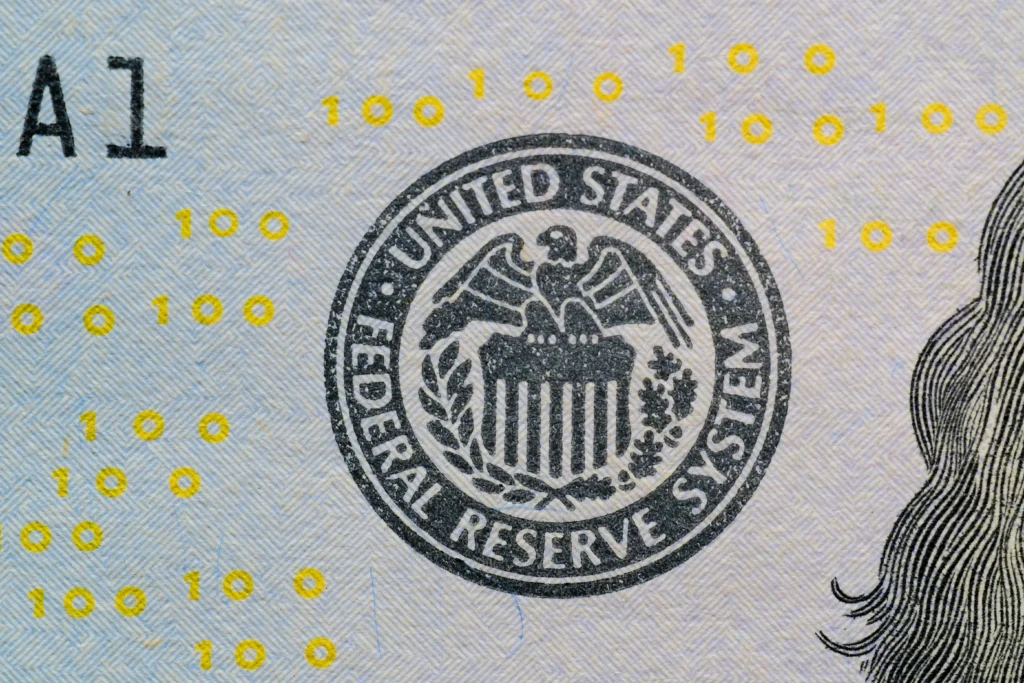
Introduction
Created in 1913 by the Federal Reserve Act, the FED (Federal Reserve System) is the central bank of the United States to whom the management of monetary policy is entrusted.
The United States Constitution gave Congress the power “to coin money and fix its value,” and monetary authority is delegated only by Congress to the Fed.
The FED is a network of 12 regional reserve banks, whose monetary policy decisions are made by the Federal Open Market Committee (FOMC), which includes the members of the Board of Governors, the president of the New York Fed, and four of the eleven other regional Fed presidents.
It is an independent institution whose decisions are neither subject to government authorization nor influenced by political cycles.
I- The monetary policy conducted by the FED
The Federal Reserve operates independently of political power; its decisions cannot be contested or called into question by the federal government, to prevent monetary policy from serving electoral or partisan interests.
Furthermore, it acts in accordance with the general economic and financial policy objectives established by the government.
So, the FED plays a central role in the monetary balance of the United States and its mission is to maintain on average a growth of monetary aggregates and the quantity of credit compatible with the growth potential of production, so as to tend towards the following objectives :
1- Promote full employment ;
2- Stabilize prices with a medium-term inflation target of 2% ;
3- Maintain moderate long-term interest rates.
In order to prevent financial crises that regularly weaken the country’s economy, the FED is content to:
- Supervise the banking system;
- Ensure financial stability;
- Maintain financial stability;
- Prevent any systemic risk;
- Providing financial services to deposit banks (including management of the electronic payment exchange system);
- Provide financial services to the federal government (such as maintaining the Treasury account);
- Publish economic analyses, including the famous Beige Book, which is a benchmark report on the state of the American economy.
In this context, the decisions of Monetary policies taken by the FED influence:
1- The availability of money in the economy;
2- The cost of credit for businesses and households;
3- The price of housing;
4- The profitability of savings,
5- The value of the dollar;
6- The growth of countries on the other side of the world.

II- The FED’s instruments
Traditionally, the policy rate has been the preferred instrument used by central banks to conduct their monetary policy. The policy rate is the interest rate applied by the central bank on loans it grants to commercial banks and on deposits it receives.
For the Fed, the key rate represents a range of interbank rates, which acts on the real economy through several channels, whether : interest rates, asset prices or the exchange rate.
Thus, by changing financing conditions, the central bank’s monetary policy is transmitted to the real economy. Generally, we can distinguish two types of tools :
1- Conventional tools
The conventional easing measures taken by the FED are transmitted to the real economy by :
A- The interest rate
The key rate is diffused to all rates and affects the demand for financing. Thus, a drop in the key rate is passed on by commercial banks to the rates of the credits they offer to households and businesses.
B- The price of assets (financial and real estate)
Acts through the wealth effect, the fall in interest rates tends to increase the valuation of assets, which increases the value of the assets of agents who, having a savings objective, can increase their investment and consumption.
C- The exchange rate
Affects the relative price of foreign goods and services, a fall in key interest rates makes domestic investments and deposits less attractive, leading to a depreciation of the currency, which increases the price competitiveness of domestic production and promotes imported inflation. This mechanism is less important in the United States, due to the dominance of the dollar in the international monetary system.
2- Unconventional tools
Developed especially since the 2008 financial crisis (subprimes), to combat the consequences of the crisis when the reduction in the key rate was not sufficient to sustainably revive activity and eliminate any deflationary risk and especially to remedy the limits of the zero lower bound rate, which once reached cannot be used further.
The central bank therefore had to rely on new tools to circumvent this limit which deprived its monetary policy of effectiveness.
Unconventional instruments are used in a complementary manner, they include :
- Large Scale Asset Purchase (LSAP), via asset purchases on the secondary market. These purchases concern securitized real estate loans (Mortgage-Backed Securities – MBS), and US Treasury bonds (Treasuries) through the quantitative easing operation, and this also affects long-term rates;
- Portfolio rebalancing: the rise in prices and the fall in yields of government securities generated by the repurchase of these assets encourage investors, who receive liquidity from the central bank, to modify the composition of their portfolio towards riskier and better-remunerated assets;
- Communication to influence rate expectations (forward guidance) in order to lower long-term interest rates. It aims to anchor the expectations of economic agents. The anticipation by economic agents of a return of inflation to its target is essential, because it influences their decisions and thus future demand, production and inflation, which takes different forms: qualitative, conditioned by a calendar, and conditioned by economic objectives;
- Long-term refinancing operations to support bank credit;
- Negative deposit rates.
These unconventional instruments can create side effects due to their more interventionist nature on financial markets.
Furthermore, the speed and extent of transmission of monetary policy to the real economy depend on several factors, namely:
- The country’s financial development and financial structure: In economies with more developed financial markets, actors have access to instruments to hedge against increases in key interest rates, which delays their impact. Furthermore, the preponderance of fixed-rate rather than variable-rate credit slows down the transmission;
- Household income and the distribution of liquid assets: households with a mortgage respond more to monetary tightening than others (except in countries that rely more on fixed rates for mortgage loans, by reducing their consumption of goods;
- The shocks facing the economy;
- The credibility of the national central bank and the effectiveness of its communication : this is a particularly important factor in emerging economies.
Thus, monetary policy transmission is more effective when inflation expectations are well anchored and central bank actions are credible. Financing conditions then tighten rapidly and the exchange rate moves accordingly, thereby limiting imported inflation.
Conclusion
For the past fifteen years, the FED has evolved the conduct of its monetary policy to deal with various crises: the financial crisis in 2008, the health crisis in 2020, the inflationary shock in 2021 amplified by Russia’s invasion of Ukraine in 2022 and finally the sovereign debt crisis.
